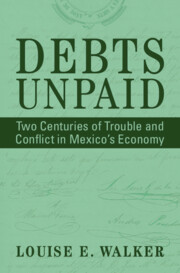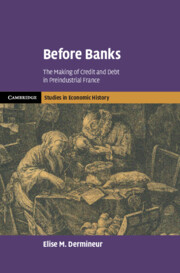Refine search
Actions for selected content:
159 results
Chapter 2 - World Literature as a Gift Economy
-
- Book:
- Five Economies of World Literature
- Published online:
- 09 December 2025
- Print publication:
- 29 January 2026, pp 49-78
-
- Chapter
- Export citation
Chapter 8 - The Costs of Conflict
- from Part III - Ripples
-
- Book:
- Violent Waters
- Published online:
- 17 December 2025
- Print publication:
- 08 January 2026, pp 217-249
-
- Chapter
- Export citation
Competition between sellers in security-bid auctions: An experimental study
-
- Journal:
- Experimental Economics ,
- Published online by Cambridge University Press:
- 11 December 2025, pp. 1-26
-
- Article
-
- You have access
- Open access
- HTML
- Export citation
Absent branches, digital presence: Fintech and the reconfiguration of everyday debt in Nigeria
-
- Journal:
- Finance and Society ,
- Published online by Cambridge University Press:
- 10 December 2025, pp. 1-17
-
- Article
-
- You have access
- Open access
- HTML
- Export citation

Debts Unpaid
- Two Centuries of Trouble and Conflict in Mexico's Economy
-
- Published online:
- 04 November 2025
- Print publication:
- 20 November 2025
4 - Little Land Banks: The Mortgaging Revolution and Savings on Bond
-
- Book:
- The Capitalist Self
- Published online:
- 12 October 2025
- Print publication:
- 30 October 2025, pp 165-196
-
- Chapter
- Export citation
7 - The Transformation of Legal Culture
-
- Book:
- The Capitalist Self
- Published online:
- 12 October 2025
- Print publication:
- 30 October 2025, pp 279-302
-
- Chapter
- Export citation

Prison and the Novel in Eighteenth-Century Britain
- Form and Reform
-
- Published online:
- 16 October 2025
- Print publication:
- 30 October 2025
1 - Citizens and Institutions
- from Part I - Context
-
- Book:
- Court, Credit, and Capital
- Published online:
- 24 November 2025
- Print publication:
- 16 October 2025, pp 29-71
-
- Chapter
- Export citation
8 - Commerce and Money Management
-
- Book:
- The Experience of Work in Early Modern England
- Published online:
- 19 September 2025
- Print publication:
- 09 October 2025, pp 285-314
-
- Chapter
-
- You have access
- Open access
- HTML
- Export citation
Martyrs, Dreams, and Past Lives: Insurgent Immortality and the Expansive Logic of Debt
-
- Journal:
- Comparative Studies in Society and History , First View
- Published online by Cambridge University Press:
- 26 September 2025, pp. 1-25
-
- Article
-
- You have access
- Open access
- HTML
- Export citation
Chapter 17 - The Uncertainty of Coming Times in Contemporary Irish Fiction
- from Part IV - Revivalist Futures
-
-
- Book:
- The Revival in Irish Literature and Culture
- Published online:
- 04 September 2025
- Print publication:
- 18 September 2025, pp 341-359
-
- Chapter
- Export citation
7 - The Economics of Climate Change
-
- Book:
- From Crisis to Action
- Published online:
- 15 August 2025
- Print publication:
- 04 September 2025, pp 143-175
-
- Chapter
-
- You have access
- Open access
- HTML
- Export citation
Some intergenerational arithmetic to control public debt in the EU
-
- Journal:
- Journal of Pension Economics & Finance , First View
- Published online by Cambridge University Press:
- 27 August 2025, pp. 1-18
-
- Article
-
- You have access
- Open access
- HTML
- Export citation
Chapter 1 - Depopulation, Debt, and Distrust
-
- Book:
- Time and Governance in Fifteenth-Century Perpignan
- Published online:
- 26 July 2025
- Print publication:
- 14 August 2025, pp 11-38
-
- Chapter
- Export citation
Chapter 3 - Generosity and Gratitude
- from Part II - Virtues of Direct Caring
-
- Book:
- Attention to Virtues
- Published online:
- 25 July 2025
- Print publication:
- 14 August 2025, pp 39-64
-
- Chapter
- Export citation
Understanding debt in the older population
-
- Journal:
- Journal of Pension Economics & Finance , First View
- Published online by Cambridge University Press:
- 15 July 2025, pp. 1-18
-
- Article
-
- You have access
- Open access
- HTML
- Export citation

Before Banks
- The Making of Credit and Debt in Preindustrial France
-
- Published online:
- 27 June 2025
- Print publication:
- 23 January 2025
Epilogue
-
- Book:
- Gift and Grit
- Published online:
- 26 May 2025
- Print publication:
- 12 June 2025, pp 212-222
-
- Chapter
- Export citation
Introduction
-
- Book:
- Gift and Grit
- Published online:
- 26 May 2025
- Print publication:
- 12 June 2025, pp 1-22
-
- Chapter
- Export citation
